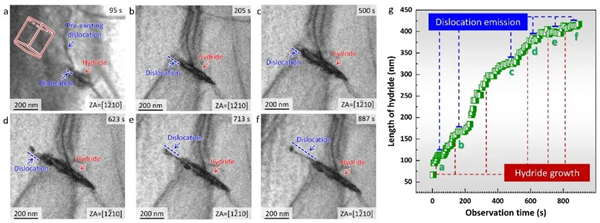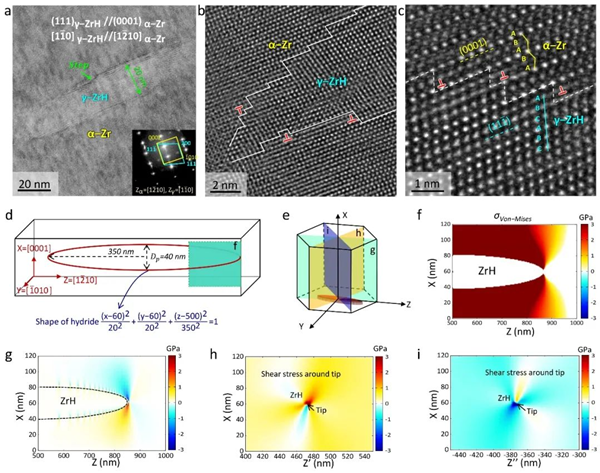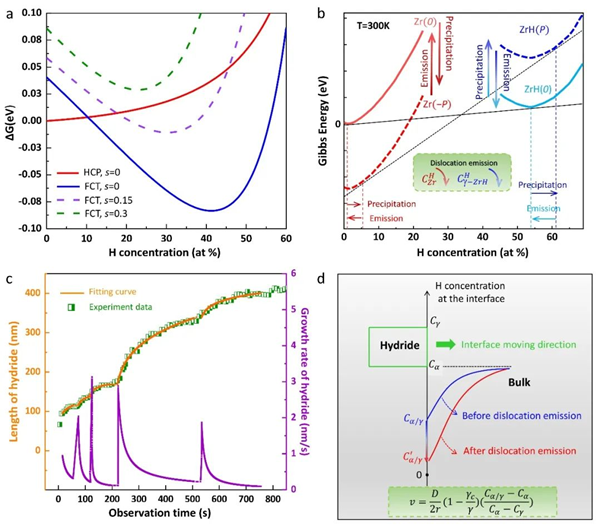Xijiao University Small: Discovery of a new mechanism of dislocation controlling zirconium hydride growth
Zirconium alloys are widely used as cladding and pressure tubes of nuclear fuel with excellent comprehensive properties. Zirconium alloys are easy to absorb hydrogen to form brittle zirconium hydride distributed along the base plane, thus accelerating the embrittlement and failure of zirconium alloy cladding. It is of great significance to clarify the nucleation and growth mechanism of hydride for inhibiting hydride precipitation and prolonging the service life of zirconium alloy cladding. This paper reveals a new mechanism of zirconium hydride precipitation and growth under dislocation control. In situ studies show that the hydride growth process presents an alternating sequence of dislocation emission - hydride growth - dislocation re emission - hydride re growth.
According to the migration characteristics of atoms, the solid state transformation of metals can be divided into diffusion type transformation and non diffusion type transformation (such as martensite transformation). There is also a type of transformation that not only generates shear, but also needs the assistance of solute atom diffusion, that is, mixed type transformation, such as bainite transformation. The precipitation of zirconium hydride has similar characteristics. It is generally believed that the sliding of Shockley dislocation and the diffusion of solid solution hydrogen atoms coordinate the precipitation of hydride. However, the detailed mechanism of its precipitation and growth lacks in-depth and intuitive in-situ research. In addition, the hydride in zirconium alloy is always wrapped by a complex dislocation structure with a bird's nest or butterfly shape. Even if the hydride decomposes during heating, the dislocation structure around it can still be preserved. Therefore, it is of great significance to clarify how such a complex dislocation structure is formed in the zirconium hydride precipitation process, and clarify the relationship between the complex dislocation structure and the zirconium hydride phase transition, so as to understand the zirconium hydride phase transition, regulate the hydride precipitation, and inhibit the hydrogen embrittlement of zirconium.

Fig. 1. Dislocation emission regulates hydride growth. (a-d) hydride growth at room temperature is accompanied by front dislocation emission; (e, f) dislocation reaction occurs in the front of hydride; (g) Hydride length versus time curve, letters in the figure correspond to figure (a-f).
The precipitation of zirconium hydride usually occurs in the cooling process from high temperature to room temperature. With the decrease of temperature, the solid solubility of hydrogen in zirconium decreases gradually, which is conducive to the nucleation and growth of hydride. This unique growth process also poses a challenge for the in-situ study of zirconium hydride. Recently, Professor Han Weizhong, School of Materials, Xi'an Jiaotong University, found that electron beam irradiation can induce the nucleation and growth of hydride in zirconium at room temperature, which provides a simple and feasible new method for in situ study of zirconium hydride phase transition process. Based on this method, the research group systematically studied the whole process of hydride nucleation and precipitation using transmission electron microscope. Hydride precipitation includes two steps: dislocation emission and hydride growth. In the study, the phase transition process of zirconium hydride is slowed down by reducing the hydrogen concentration (zirconium absorbs a small amount of hydrogen in the double jet process). The high-resolution camera captures that dislocation emission and hydride growth are alternately advancing processes, such as dislocation emission - hydride growth - dislocation re emission - hydride re growth (Figure 1), rather than synchronous processes. High resolution electron microscope observation shows that there are uneven steps at the interface between the hydride front and the matrix, which provides favorable conditions for dislocation emission at the hydride front (Fig. 2).

Fig. 2. Atomic structure and stress field of hydride front. (a-c) γ- Hydride and parent phase α- Atomic image of the interface between Zr. (d) Shape model of needle hydride. (e) Schematic diagram of hydride and prismatic slip system in Zr. (f) Von Mises stress around the hydride front. (g-i) Shear stress component τ The projection of yz on three cylindrical slip systems.
Density functional theory calculation shows that the hydride phase transition produces tensile stress in the zirconium matrix and compressive stress in the hydride. The tensile stress generated by the volume expansion of zirconium hydride phase transformation is sufficient to stimulate the dislocation slip of the cylinder, cone and base plane in zirconium, which makes it possible to form the complex dislocation structure around the hydride (Fig. 2). Through the calculation and analysis of free energy, it is found that the volume expansion caused by hydride phase transformation is not conducive to the continuous precipitation and growth of hydride. When hydride is in phase transition, the tensile stress in the matrix increases the solid solubility of hydrogen at the front of hydride interface, and the driving force of phase transition decreases. When dislocations are emitted from the hydride front, the tensile stress of the surrounding matrix decreases, and the solid solubility of hydrogen at the interface front decreases, reaching the hydrogen supersaturation state, promoting the further precipitation of hydride. In addition, dislocation emission can increase the concentration gradient of hydrogen in the hydride front and zirconium matrix, accelerate the precipitation rate of zirconium hydride, and promote the growth of hydride (Fig. 3).

Fig. 3 Gibbs free energy curve of hydride precipitation. (a) The Gibbs free energy of each Zr atom in HCP and FCT structures varies with hydrogen concentration and stress. (b) Effect of dislocation emission on Zr Gibbs free energy curves of hydride and parent phase. The red curve is α- Gibbs free energy curve of Zr, when hydride grows, α- The tensile stress is accumulated in Zr, Gibbs free energy is reduced, and hydrogen α- The solubility in Zr increases; When the dislocation is emitted, the stress is released, and the hydrogen α- The solubility in Zr decreases, promoting hydride interface migration. (c) The change of hydride length with time and its growth rate curve. (d) Hydrogen concentration and hydrogen concentration gradient at the interface before and after dislocation emission.
In a word, zirconium hydride precipitation is a mixed phase transition process jointly controlled by dislocation emission and hydrogen diffusion. The precipitation of zirconium hydride causes the tensile stress in the surrounding zirconium matrix, which promotes the enrichment of hydrogen towards the hydride tip, but the tensile stress increases the solid solubility of hydrogen, which is not conducive to further phase transformation; The dislocation emission releases the tensile stress in the zirconium matrix, reduces the solid solubility of hydrogen, and promotes the growth of zirconium hydride; The growth rate of zirconium hydride after dislocation emission shows the characteristics of first fast and then slow, which is due to the tensile stress in the zirconium matrix and the internal compressive stress in the hydride gradually increase due to the further precipitation of zirconium hydride, until the phase transformation is completely suppressed. The volume expansion stress of zirconium hydride precipitates excites multiple slip systems in the zirconium matrix, and the dislocation interaction on multiple slip systems forms a complex bird's nest or butterfly like dislocation structure around the hydride.
The research results were published in the academic journal Small under the title of "Distribution Mediated Hydraulic Precision in Zirconium", with an impact factor of 13.281. Liu Siming, a doctoral student, is the first author of the paper, and Professor Han Weizhong is the first corresponding author of the paper. The collaborators include Dr. Akio Ishii, Professor Mi Shaobo, Professor Shigenobu Ogata and Professor Li Ju.

